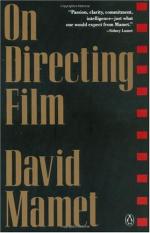
|
| Name: _________________________ | Period: ___________________ |
This test consists of 15 multiple choice questions and 5 short answer questions.
Multiple Choice Questions
1. According to Mamet in Chapter 5, what is the perfect movie?
(a) Breakfast at Tiffany's.
(b) It's a Wonderful Life.
(c) Casablanca.
(d) Dumbo.
2. Mamet says that if you are telling the story with pictures, the dialogue is the sprinkles on the what?
(a) Icing.
(b) Cupcake.
(c) Cake.
(d) Ice cream cone.
3. What was the last beat about in the hypothetical film in Chapter 5?
(a) A man sells a pig.
(b) A man rewards a good deed.
(c) A man sells a goat.
(d) A man saves the day.
4. What was in the pen in the ending of the story in Chapter 5?
(a) Children.
(b) Piglets.
(c) Food.
(d) No pig.
5. Mamet says the reason we like those old-time movie stars so much is that they are what?
(a) Simple.
(b) Concrete.
(c) Honest.
(d) Elaborate.
6. What does Mamet say that dramatic analysis is like in Chapter 6?
(a) Solving a math equation.
(b) Plotting a compass course.
(c) Literary analysis.
(d) Critical thinking.
7. What was the steamboat captain's answer to Stanislavsky, in Chapter 6?
(a) "I stick to the channel; it's marked."
(b) "I have a sounding beacon."
(c) "I use a map."
(d) "I drink a lot of water."
8. The purpose of rehearsal is to tell the actors, beat by beat, what?
(a) The objectives.
(b) The actions called for.
(c) The emotions needed.
(d) The characterization.
9. Where did the farmer go in the town in the hypothetical film of Chapter 5?
(a) The farm.
(b) The farmer's market.
(c) The seed store.
(d) The slaughterhouse.
10. Stanislavsky wrote that the difficult will become easy and the easy habitual, so that the habitual may become what?
(a) True.
(b) Honest.
(c) Beautiful.
(d) Exact.
11. What do actors erroneously try to use their intellectuality to do?
(a) Portray the idea of a movie.
(b) Show the ending in the scene.
(c) Portray a sense of character.
(d) Create subdramas.
12. After how many takes does Mamet say you can no longer remember what the scene was about, in Chapter 4?
(a) Three.
(b) Five.
(c) Ten.
(d) Six.
13. What does Mamet say is useless filler in film, and the giveaway to a joke's punch line, in Chapter 5?
(a) Obstacle.
(b) Drama.
(c) Signposts.
(d) Exposition.
14. What is the book of pictures of shots of a film called?
(a) The storyboard.
(b) The set design.
(c) The prompt book.
(d) The book.
15. What actress did Mamet mention in the footnotes of Chapter 5 as an actress who could truly act?
(a) Donna Reed.
(b) Susan Sarandon.
(c) Mary Astor.
(d) Meryl Streep.
Short Answer Questions
1. Mamet says that the greatest lesson in acting is to perform the physical motions of the script, how?
2. According to Mamet in Chapter 5, why did Oedipus have to find out who his parents were?
3. According to Mamet, what do actors talk about, which does not exist on the stage?
4. According to Mamet in Chapter 5, having two reasons for an act are the same as having how many reasons?
5. What is the subheading of Chapter 4?
|
This section contains 495 words (approx. 2 pages at 300 words per page) |

|




